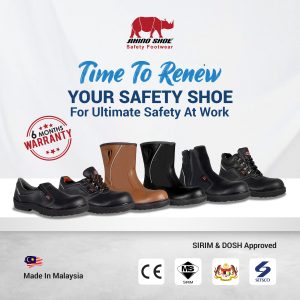Safety standards and certifications are introduced to ensure the safety and quality of a product. The standards are established by international organizations and governments to protect workers in different industries from workplace hazards and injuries.
Safety footwear’s quality and performance are tested and measured under certain standards and certifications to ensure necessary protection, comfort, and durability assurance. The results were collected from the testing process including a range of physical and laboratory tests, such as impact resistance tests, penetration resistance tests, sole slip resistance tests, and more.
The most common standards and certifications for safety footwear include:
EN ISO 20345: A European standard for safety footwear that covers a wide range of requirements, including impact resistance, penetration resistance, sole slip resistance, and more. Safety footwear that meets the EN ISO 20345 standard is commonly used in Europe and other countries that follow European regulations.
ASTM F2413: An American standard for safety footwear that covers similar requirements to the EN ISO 20345 standard, including impact resistance, penetration resistance, and sole slip resistance. ASTM F2413 is commonly used in the United States and other countries that follow American regulations.
SIRIM MS ISO 20345: A Malaysian standard for safety footwear that is based on the EN ISO 20345 standard, with some additional requirements specific to the Malaysian market. SIRIM MS ISO 20345 is commonly used in Malaysia and other countries in Southeast Asia.
AS/NZS 2210.3: An Australian/New Zealand standard for safety footwear that covers similar requirements to the EN ISO 20345 standard, with some additional requirements specific to the Australian and New Zealand markets.
SS 513: A Singaporean standard for safety footwear that covers similar requirements to the EN ISO 20345 standard, with some additional requirements specific to the Singaporean market.
S3: A safety classification for safety footwear that indicates a higher level of protection and performance than the basic EN ISO 20345 standard. The S3 classification requires safety footwear to have additional features such as waterproofing, energy absorption, and anti-static properties.
It is important to note that safety footwear should be selected based on the specific hazards present in the workplace and the level of protection required. Employers and employees should consult with a qualified professional to ensure that the safety footwear meets the necessary standards and certifications and provides adequate protection for the intended use.

Safetyware’s RHINO SHOE Ultranite series are tested and certified under the:
- CE EN ISO 20345:2011
- SIRIM MS ISO 20345 : 2008 SB HRO
- DOSH (JKKP SS 133/19)
- SS 513 Part 1: 2013 (S1P HRO SRC)
RHINO SHOE is made to offer necessary protection with ultimate comfort and rock-solid toughness elegant design at affordable prices.
